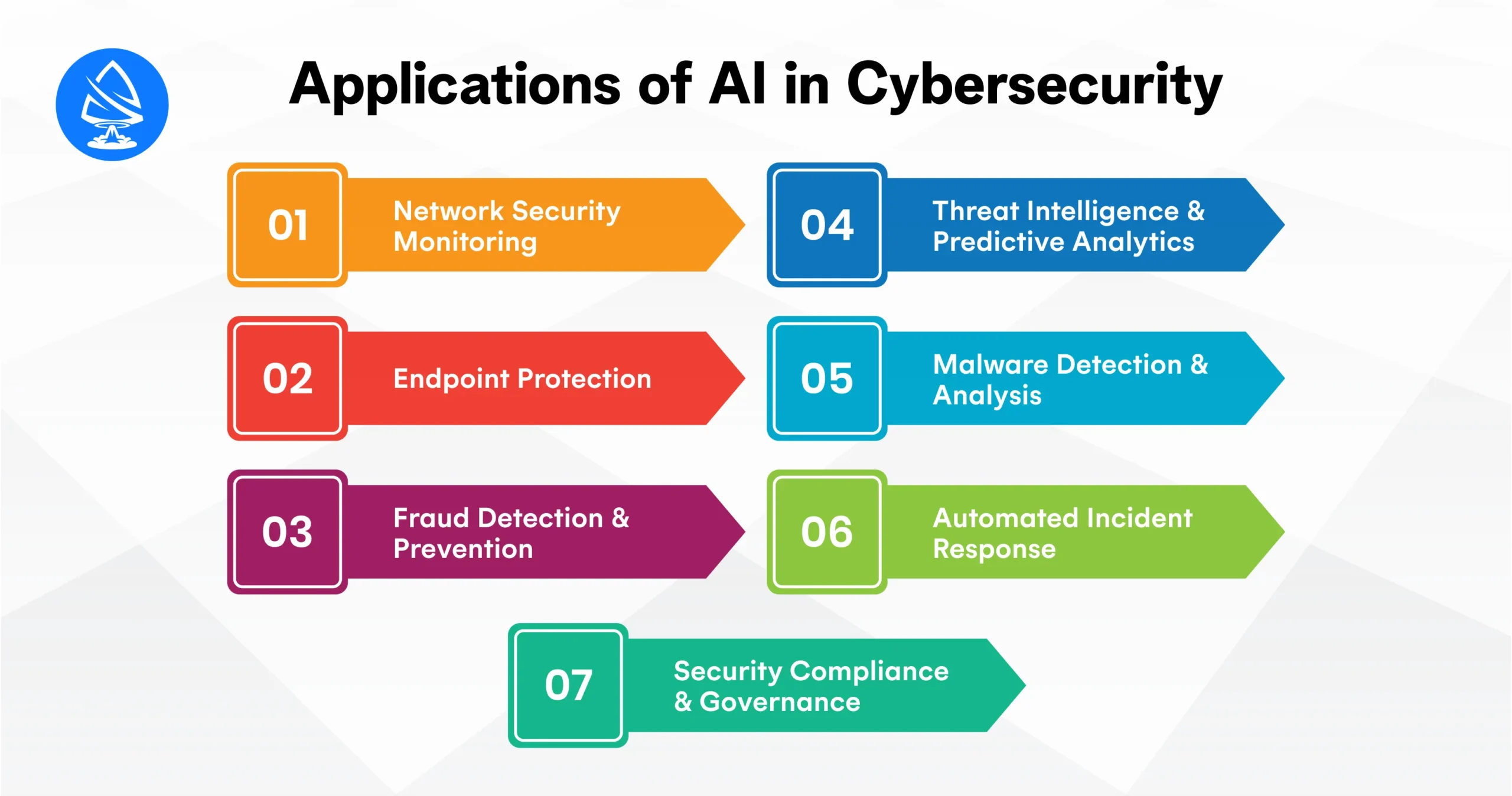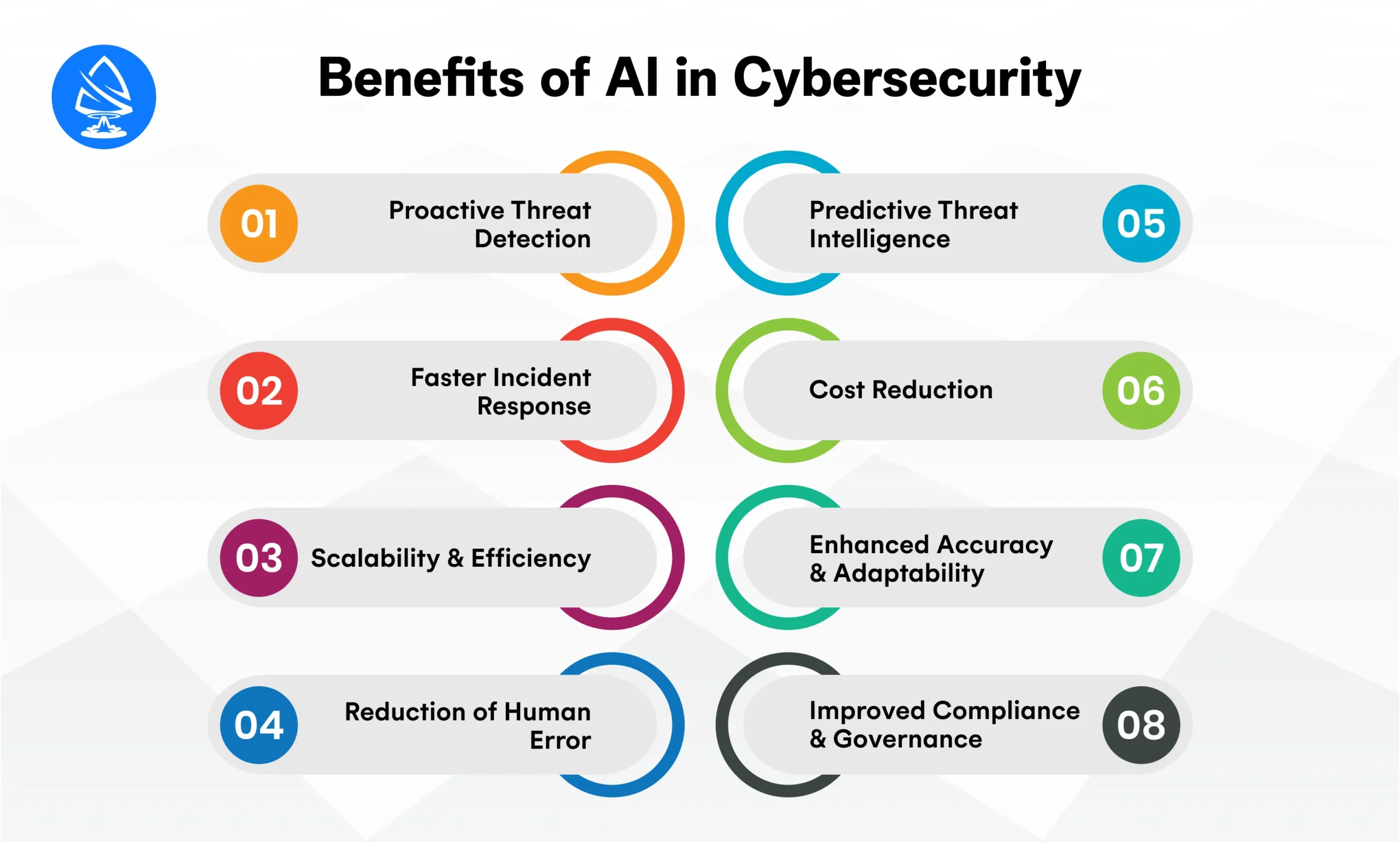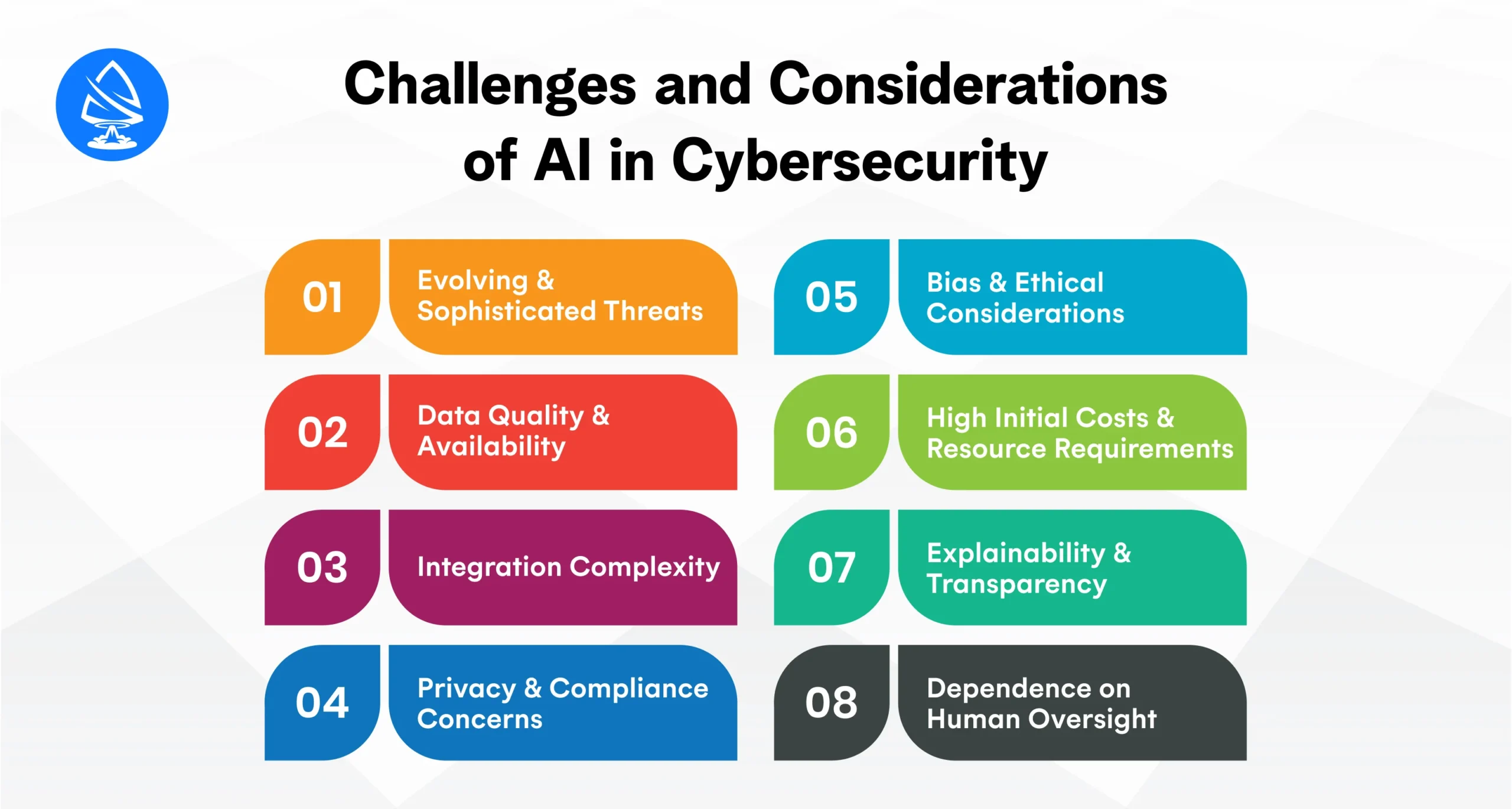In an more and more digitized world, cybersecurity threats are rising in complexity and frequency. Conventional rule-based safety techniques are now not ample to guard delicate information, networks, and functions from refined cyberattacks. Enter AI in cybersecurity, a transformative expertise that leverages machine studying, deep studying, and superior analytics to detect, stop, and reply to threats in real-time.
AI-driven safety options present proactive protection mechanisms, enabling organizations to anticipate assaults, establish anomalies, and mitigate dangers quicker than human analysts alone. From primary signature-based detection to superior deep studying fashions able to recognizing zero-day assaults, the evolution of AI in cybersecurity displays the necessity for extra clever, adaptive, and scalable safety techniques.
What’s AI in Cybersecurity?
AI in cybersecurity refers back to the utility of synthetic intelligence applied sciences to guard digital techniques, networks, and information from cyber threats. Not like conventional cybersecurity strategies that depend on predefined guidelines and handbook monitoring, AI leverages machine studying, deep studying, and superior analytics to detect anomalies, predict potential threats, and reply to incidents in real-time.
At its core, AI in cybersecurity permits techniques to study from information, acknowledge patterns, and make knowledgeable selections autonomously or with minimal human intervention. This makes it notably efficient towards refined and evolving cyberattacks that will bypass rule-based defenses.
Key Capabilities of AI in Cybersecurity

Menace Detection and Prevention
AI analyzes community site visitors, system logs, and person conduct to establish irregular actions that would point out cyberattacks. This proactive strategy permits companies to stop breaches earlier than they happen.
Instance: AI can detect uncommon login makes an attempt from a overseas IP deal with, flagging potential account compromise in real-time.
Automated Incident Response
AI can reply to detected threats mechanically by isolating compromised techniques, blocking malicious site visitors, or alerting safety groups, decreasing the time between detection and mitigation.
Instance: In a ransomware assault, AI can instantly quarantine affected recordsdata and stop the malware from spreading throughout the community.
Behavioral Evaluation
By monitoring person and system conduct over time, AI identifies deviations that will sign insider threats, fraud, or compromised credentials.
Instance: An AI system can detect if an worker instantly accesses delicate recordsdata at uncommon hours, triggering an investigation.
Predictive Menace Intelligence
AI analyzes historic and real-time information to foretell potential vulnerabilities and assault vectors, enabling proactive protection methods.
Instance: AI-driven menace intelligence can forecast phishing campaigns concentrating on an organization primarily based on rising patterns.
Malware and Anomaly Detection
Machine studying fashions can classify unknown malware and detect beforehand unseen threats by recognizing patterns in code or community conduct.
Instance: AI can establish a brand new malware variant making an attempt to use a zero-day vulnerability, even when it hasn’t been seen earlier than.
The Early Period: Rule-Based mostly Cybersecurity
Initially, cybersecurity relied closely on rule-based techniques, also referred to as signature-based detection. These techniques operated on predefined guidelines and identified menace signatures.
Traits of Rule-Based mostly Methods:
- Detect solely identified threats
- Rely on frequent handbook updates
- Restricted capacity to adapt to new assault vectors
Instance: Antivirus software program that identifies malware by matching it towards a database of identified virus signatures.
Limitations:
- Ineffective towards zero-day assaults or unknown malware
- Excessive dependence on human analysts for updates and monitoring
- Struggled to deal with advanced, multi-stage assaults
The Shift to AI-Powered Cybersecurity
With the rise of refined assaults, AI started to play a important position in enhancing cybersecurity. Machine studying algorithms allowed techniques to study from historic information and detect anomalies past easy rule-matching.
Developments Launched:
- Behavioral Evaluation – Monitoring person and system behaviors to detect uncommon exercise.
- Anomaly Detection – Figuring out deviations from regular patterns that will point out threats.
- Predictive Analytics – Anticipating potential assaults primarily based on historic traits.
Instance: An enterprise community makes use of AI in community safety to flag uncommon login makes an attempt from overseas areas, even when no identified malware is detected.
Advantages:
- Actual-time menace detection
- Lowered reliance on handbook updates
- Enhanced adaptability to evolving cyber threats
Deep Studying and Superior AI in Cybersecurity
The following leap in cybersecurity concerned deep studying fashions, which might course of advanced, high-dimensional information and acknowledge refined patterns indicative of cyber threats. Deep studying permits:
- Detection of zero-day assaults
- Identification of spear-phishing emails or refined malware
- Automated triaging and menace prioritization
Instance: AI safety options utilizing deep studying can scan hundreds of thousands of community occasions and detect malware variants that conventional signature-based techniques would miss.
Key Applied sciences:
- Neural Networks for Sample Recognition
- Pure Language Processing (NLP) for analyzing malicious emails or communications
- Reinforcement Studying for adaptive menace mitigation methods
Functions of AI in Cybersecurity
The combination of AI in cybersecurity has revolutionized how organizations defend their digital belongings, detect threats, and reply to incidents. By leveraging machine studying, deep studying, and predictive analytics, AI permits automated, clever, and real-time safety options throughout a number of domains. Right here’s an in depth exploration of the important thing functions of AI in cybersecurity:

1. Community Safety Monitoring
AI-powered techniques repeatedly monitor community site visitors, on the lookout for anomalies and suspicious patterns that will point out cyberattacks. Conventional strategies typically depend on static guidelines, which might be bypassed, whereas AI adapts and learns from rising threats.
Capabilities:
- Detect uncommon entry makes an attempt or site visitors spikes
- Determine potential intrusion or malware exercise
- Monitor inside and exterior community communications in real-time
Instance: A company community makes use of AI to detect a sequence of failed login makes an attempt from an unfamiliar IP vary, mechanically triggering alerts and blocking entry to stop unauthorized entry.
Advantages:
- Sooner detection of threats
- Lowered handbook monitoring workload
- Enhanced safety towards zero-day assaults
2. Endpoint Safety
Endpoints reminiscent of laptops, servers, and IoT units are widespread targets for cyberattacks. AI enhances endpoint safety by analyzing behavioral patterns and figuring out irregular actions.
Capabilities:
- Detect suspicious file modifications or software program installations
- Determine malware and ransomware variants
- Mechanically isolate compromised units
Instance: AI safety options on worker laptops can detect ransomware encrypting recordsdata and mechanically halt the method earlier than it spreads.
Advantages:
- Proactive menace mitigation
- Lowered threat of lateral motion throughout networks
- Steady endpoint monitoring with out handbook intervention
3. Fraud Detection and Prevention
AI in cybersecurity is especially efficient in detecting monetary fraud, analyzing transaction patterns, and figuring out anomalies in real-time.
Capabilities:
- Monitor bank card and banking transactions
- Determine uncommon patterns indicative of fraud
- Present predictive insights for proactive threat administration
Instance: A banking establishment makes use of AI algorithms to flag suspicious transactions, reminiscent of a big abroad buy that deviates from a buyer’s typical conduct, stopping potential monetary loss.
Advantages:
- Lowered fraudulent exercise
- Improved buyer belief and compliance
- Sooner detection of suspicious transactions
4. Menace Intelligence and Predictive Analytics
AI gathers and analyzes menace intelligence from a number of sources to anticipate potential assaults. Predictive fashions establish vulnerabilities earlier than attackers exploit them.
Capabilities:
- Mixture menace information from open-source feeds, darkish net, and inside logs
- Predict assault traits primarily based on historic information
- Present actionable intelligence to safety groups
Instance: AI safety corporations use predictive analytics to forecast phishing campaigns concentrating on particular industries, enabling proactive protection and worker coaching.
Advantages:
- Anticipates assaults earlier than they happen
- Enhances proactive cybersecurity measures
- Optimizes useful resource allocation for safety groups
5. Malware Detection and Evaluation
Machine studying and deep studying fashions enable AI to detect and classify malware, together with beforehand unknown variants, by analyzing conduct quite than relying solely on identified signatures.
Capabilities:
- Behavioral evaluation of recordsdata and applications
- Actual-time scanning for anomalies in system operations
- Automated classification of malicious software program
Instance: An enterprise AI safety answer detects a brand new malware pressure making an attempt to use a zero-day vulnerability, quarantines it, and updates menace intelligence for all techniques.
Advantages:
- Identifies new and evolving threats
- Reduces reliance on handbook malware analysis
- Improves response velocity and containment
6. Automated Incident Response
AI permits automated response to detected safety incidents, decreasing response time and minimizing harm.
Capabilities:
- Isolate compromised techniques mechanically
- Block malicious IP addresses or suspicious site visitors
- Set off alerts and reviews for safety groups
Instance: Throughout a phishing assault, AI detects suspicious emails, blocks supply, and alerts the IT workforce, stopping workers from interacting with malicious content material.
Advantages:
- Sooner menace containment
- Reduces the workload on safety analysts
- Improves general incident response effectivity
7. Safety Compliance and Governance
AI helps organizations monitor compliance with cybersecurity insurance policies and regulatory necessities, offering real-time auditing and reporting.
Capabilities:
- Monitor person exercise and entry rights
- Guarantee adherence to GDPR, HIPAA, or PCI DSS requirements
- Detect coverage violations and potential dangers
Instance: A healthcare group makes use of AI safety techniques to repeatedly monitor entry to affected person information, guaranteeing compliance with HIPAA laws.
Advantages:
- Reduces threat of non-compliance penalties
- Enhances governance and accountability
- Gives detailed audit trails for regulatory functions
Advantages of AI in Cybersecurity
The combination of AI in cybersecurity gives transformative benefits that transcend conventional safety measures. By leveraging machine studying, deep studying, and superior analytics, AI permits organizations to proactively detect, stop, and reply to cyber threats with unmatched effectivity. Right here’s an in depth have a look at the important thing advantages:

1. Proactive Menace Detection
AI techniques repeatedly analyze community site visitors, system logs, and person conduct to establish potential threats earlier than they will trigger harm. Not like rule-based safety, which solely reacts to identified threats, AI can acknowledge anomalies and patterns indicative of novel assaults.
Instance: AI detects uncommon login makes an attempt from a number of areas, signaling a possible account takeover try.
Profit: Reduces breaches and mitigates dangers in real-time, enhancing general safety posture.
2. Sooner Incident Response
AI-powered techniques can automate response actions, considerably decreasing the time between detection and remediation.
Capabilities:
- Isolate compromised endpoints
- Block suspicious IP addresses
- Alert safety groups with actionable insights
Instance: Within the occasion of a ransomware assault, AI can quarantine contaminated recordsdata instantly, stopping lateral motion throughout the community.
Profit: Minimizes operational disruption and harm brought on by cyberattacks.
3. Scalability and Effectivity
AI can course of and analyze large quantities of knowledge from a number of sources concurrently, one thing human groups can’t obtain effectively.
Instance: Monitoring hundreds of thousands of person transactions for fraud or anomalies throughout international branches of a monetary establishment.
Profit: Ensures real-time menace detection and safety at enterprise scale with out exponential will increase in safety workers.
4. Discount of Human Error
Handbook monitoring and evaluation are liable to errors and oversight, particularly when dealing with excessive volumes of knowledge. AI reduces these dangers by offering constant and correct evaluation.
Instance: AI techniques can detect refined deviations in community site visitors that may be ignored by human analysts.
Profit: Improves accuracy in figuring out threats and reduces false positives.
5. Predictive Menace Intelligence
AI can anticipate future threats utilizing predictive analytics, analyzing historic assault patterns, rising traits, and behavioral anomalies.
Instance: Predicting phishing campaigns concentrating on a particular business primarily based on earlier assault information.
Profit: Allows proactive measures, decreasing the probability of profitable cyberattacks.
6. Value Discount
By automating repetitive monitoring, detection, and incident response duties, AI reduces reliance on giant safety groups.
Instance: Automated malware scanning and anomaly detection scale back the necessity for twenty-four/7 human monitoring.
Profit: Decrease operational prices whereas enhancing general safety effectiveness.
7. Enhanced Accuracy and Adaptability
AI techniques repeatedly study from new threats and suggestions, permitting them to adapt to evolving assault methods.
Instance: Deep studying fashions detect beforehand unknown malware variants by analyzing behavioral patterns quite than relying solely on signature databases.
Profit: Gives resilient, adaptive safety able to dealing with rising cyber threats.
8. Improved Compliance and Governance
AI can monitor regulatory compliance mechanically, guaranteeing adherence to requirements reminiscent of GDPR, HIPAA, or PCI DSS.
Capabilities:
- Observe person exercise and information entry
- Generate compliance reviews
- Detect coverage violations
Instance: Healthcare organizations can use AI to watch entry to affected person information, guaranteeing compliance with HIPAA necessities.
Profit: Reduces threat of penalties and improves accountability.
Challenges and Concerns of AI in Cybersecurity
Whereas AI in cybersecurity gives transformative advantages, implementing and managing AI-driven safety techniques comes with its personal set of challenges. Organizations should rigorously deal with these concerns to maximise effectiveness whereas mitigating potential dangers. Under is an in depth exploration of the primary challenges and concerns:

1. Evolving and Subtle Threats
Cyber threats are always altering, with attackers growing new methods to bypass AI-driven defenses. AI fashions educated on historic information might battle to detect fully novel or extremely refined assaults.
- Instance: Superior persistent threats (APTs) or zero-day exploits might evade detection if AI techniques haven’t encountered comparable patterns earlier than.
- Consideration: Steady mannequin updates and integration of menace intelligence feeds are important to make sure AI techniques stay efficient towards evolving threats.
2. Knowledge High quality and Availability
AI techniques depend on giant volumes of high-quality information for coaching and real-time evaluation. Poor-quality, incomplete, or biased information can degrade AI efficiency and result in inaccurate menace detection.
- Instance: If community logs include lacking or inconsistent data, anomaly detection algorithms might generate false positives or miss precise threats.
- Consideration: Implement rigorous information validation, cleaning, and aggregation procedures to take care of correct and dependable enter for AI fashions.
3. Integration Complexity
Integrating AI cybersecurity options with present IT infrastructure, legacy techniques, and enterprise functions might be technically difficult. Points embody compatibility, information change, and workflow orchestration.
- Instance: An organization might battle to combine AI menace detection with an older firewall or SIEM system.
- Consideration: Plan phased integration, use standardized APIs, and leverage middleware platforms to make sure seamless connectivity.
4. Privateness and Compliance Considerations
AI techniques typically course of delicate and personally identifiable data, elevating privateness and regulatory compliance challenges. Mismanagement can result in information breaches or authorized penalties.
- Instance: AI monitoring worker conduct or processing affected person information should adjust to GDPR or HIPAA requirements.
- Consideration: Implement strict entry controls, encryption, anonymization, and compliance checks all through AI workflows.
5. Bias and Moral Concerns
AI fashions can inadvertently inherit biases from coaching information, resulting in unfair or discriminatory outcomes in menace detection and response. Moral issues additionally come up round automated decision-making.
- Instance: AI would possibly disproportionately flag sure person teams as suspicious primarily based on biased historic information.
- Consideration: Commonly audit AI outputs, apply equity algorithms, and set up moral pointers for AI deployment.
6. Excessive Preliminary Prices and Useful resource Necessities
Deploying AI cybersecurity techniques might be resource-intensive, requiring:
- Expert personnel for setup and upkeep
- Funding in {hardware} or cloud infrastructure
- Prices related to ongoing mannequin coaching and updates
Consideration: Begin with high-priority use circumstances or pilot tasks to guage ROI earlier than scaling enterprise-wide.
7. Explainability and Transparency
Many AI techniques, notably deep studying fashions, operate as “black containers”, making it obscure why a specific resolution or alert was generated.
- Instance: Safety analysts might discover it difficult to justify automated responses to administration or regulators if the reasoning is unclear.
- Consideration: Implement explainable AI (XAI) approaches to supply transparency and help decision-making processes.
8. Dependence on Human Oversight
Though AI can automate detection and response, human experience continues to be important for deciphering alerts, dealing with advanced incidents, and validating AI-driven selections. Over-reliance on AI might end in oversight of nuanced threats.
- Consideration: Mix AI automation with expert cybersecurity groups to make sure efficient menace administration.
Future Tendencies in AI Cybersecurity
- Autonomous Cyber Protection – AI techniques able to responding to threats with out human intervention
- Integration with IoT Safety – Defending linked units from cyber threats
- Generative AI in Safety Testing – Simulating assaults to strengthen defenses
- Explainable AI (XAI) – Clear AI fashions to make sure accountability and belief
Instance: AI cybersecurity corporations are exploring generative AI to simulate phishing assaults, enabling organizations to coach workers and refine protection mechanisms.
Conclusion
The evolution of AI in cybersecurity from rule-based techniques to superior deep studying fashions has reworked the way in which companies defend their digital belongings. By leveraging AI applied sciences, organizations can detect threats proactively, reply quicker, and achieve precious insights to enhance their general safety posture. Whereas challenges reminiscent of integration complexity, privateness, and evolving threats exist, AI-powered cybersecurity options present unparalleled scalability, accuracy, and effectivity.
As cyber threats proceed to develop, investing in AI cybersecurity corporations and AI safety options turns into important for enterprises aiming to safeguard delicate information and keep belief.
Able to safe your corporation with cutting-edge AI in cybersecurity? Use our Value Calculator to discover AI safety options tailor-made to your enterprise.
Often Requested Questions
1. What’s AI in cybersecurity?
AI in cybersecurity refers to using synthetic intelligence applied sciences to detect, stop, and reply to cyber threats.
2. How does AI enhance menace detection?
AI analyzes giant datasets, acknowledges anomalies, and identifies patterns indicative of assaults quicker than conventional techniques.
3. Can AI detect zero-day assaults?
Sure, deep studying fashions can establish beforehand unknown threats primarily based on behavioral patterns and anomalies.
4. What industries profit most from AI in cybersecurity?
Finance, healthcare, e-commerce, important infrastructure, and expertise corporations profit considerably.
5. Are AI safety options absolutely autonomous?
Some AI techniques are autonomous, however most work finest when mixed with human oversight for important selections.
6. What are the restrictions of AI in cybersecurity?
Challenges embody information privateness issues, evolving threats, advanced integration, and excessive preliminary prices.
7. How do AI cybersecurity corporations help companies?
They supply AI safety options, monitoring, menace intelligence, and incident response techniques tailor-made to enterprise wants.
8. Is AI cybersecurity scalable?
Sure, AI techniques can deal with large quantities of community site visitors and person information, making them extremely scalable.




